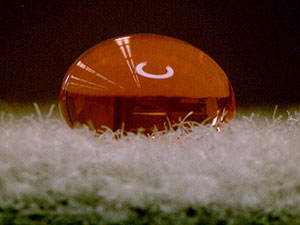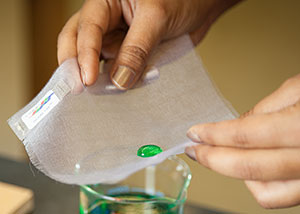University of Houston Launches First Nanotech Company
C-Voltaics Produces Self-Cleaning Hydrophobic Nano-Coatings

Juice droplet on carpet treated with C-Voltaic’s self-cleaning nano-coating; the
juice will not stain the carpet even after being left there for 24 hours.Out of the test-tube, onto your jeans? How about your patio deck?
A physics researcher from the University of Houston has turned his nanotechnology research into reality, launching a nanotech manufacturing company in the University's Energy Research Park.
C-Voltaics will manufacture the coatings, designed to protect fabric, wood, glass and a variety of other products from water, stains, dust and other environmental hazards.
"After you wash your jeans, the color starts to fade. It means you can keep your jeans looking better, longer," Seamus "Shay" Curran, director of UH's Institute for NanoEnergy, said. "Or you might have a very nice white blouse, but the minute you get ketchup or wine on it, you know you're going to have to throw it out. You're not going to have to throw things away because of fading or stains."
The coatings, technically known as self-cleaning hydrophobic nano-coatings, are designed to repel the elements. Curran said they will be competitively priced.

Coating keeps liquid from running through sheer fabric."If you want to have a successful business, it's got to be better and cheaper," said
Curran, an associate professor of physics at UH. "Consumers aren't going to pay for
it if it's not."
UH is a shareholder in C-Voltaics, which Chief Energy Officer Ramanan Krishnamoorti said is the first nanotechnology company to be spun off from the University.
Curran developed the coatings in conjunction with his work on portable, solar-powered generators. Solar panels work most efficiently if their surfaces are clean, and the coating acts as a protective barrier against dust, pollen, water and other pollutants.
His solar-powered generator, known as the Storm Cell, also is licensed to C-Voltaics, but Curran said the company will first focus on producing the coatings.
The coatings are slightly different chemically for each type of material to be treated, although Curran said the base chemistry is the same. They will be produced at the Energy Research Park, and Curran said he expects production to reach at least 400 gallons a day by the end of September.
Based on customer demand, it could be far higher by next year, he said.
Initially, C-Voltaics will sell the coatings to other businesses, although Curran said a consumer product could be in stores as early as next spring.
"We should have a product you could apply to your own garden fence, your own garden wall," he said. No deal with a retailer has been signed.
C-Voltaics received the Young Technology Award at the Commercialization of Micro- and Nanosystems conference in The Netherlands last week, a competition for nanotechnology companies that are less than 10 years old. Judges based their decision on expected return on investment.
C-Voltaics also has been named a finalist for the 2013 Goradia Innovation Prize, which recognizes the best innovations from the Houston Gulf Coast region.
C-Voltaics is a high-profile example of the University's strategy of moving more of its faculty research into commercial ventures.
"The University's strategy for the commercialization of our faculty's discoveries is to identify the most innovative technologies, those that have the greatest potential to benefit society," said Rathindra Bose, vice president for research and technology transfer at UH.
Bose noted that one of the advantages of Curran's work is that the chemicals used are non-toxic. "His discoveries seem to have great potential to meet industry's need for an environmentally friendly material that improves the performance of solar cells," he said.
But the coating will also be used on a wide variety of other materials.
Nigel Alley, a research professor in the UH physics department and a member of Curran's research group, said the fabric coating will last as long as the fabric lasts.
Alley said the coating can be tailored to customers' specifications, depending on how long they require a product to resist water or other pollutants.
Curran said the coating won't become damaged by the elements, but routine wear and tear may damage the underlying wood on products such as patio decking, requiring the coating to be reapplied every few years.
The company offers the potential for the University to earn royalties it can invest in students and equipment, Curran said. But he said it also offers evidence that nanotechnology is ready for commercial applications.
"Nanomaterials are a way of using less material but having them be more efficient," he said. "You have something that adds a lot of functionality to the end product."
- Jeannie Kever, University Communication